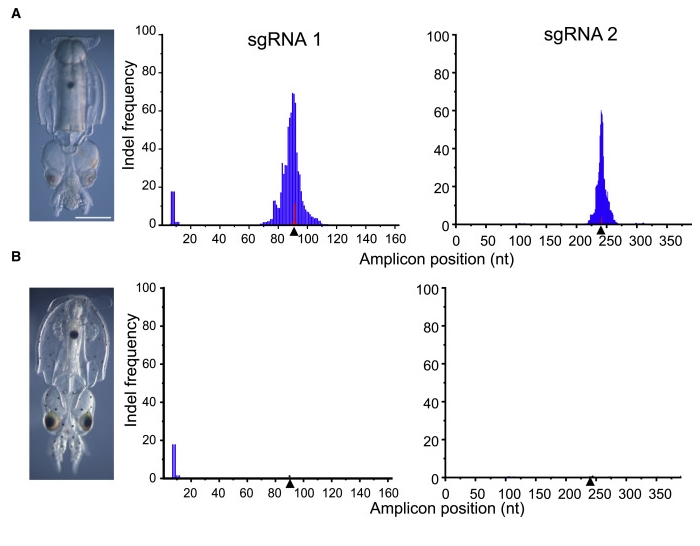First gene knockout in a cephalopod achieved
A team at the Marine Biological Laboratory (MBL) has achieved the first gene knockout in a cephalopod using the squid Doryteuthis pealeii, an exceptionally important research organism in biology for nearly a century. The milestone study, led by MBL Senior Scientist Joshua Rosenthal and MBL Whitman Scientist Karen Crawford, is reported in the July 30 issue of Current Biology.
The team used CRISPR-Cas9 genome editing to knock out a pigmentation gene in squid embryos, which eliminated pigmentation in the eye and in skin cells (chromatophores) with high efficiency.
"This is a critical first step toward the ability to knock out -- and knock in -- genes in cephalopods to address a host of biological questions," Rosenthal says.
Cephalopods (squid, octopus and cuttlefish) have the largest brain of all invertebrates, a distributed nervous system capable of instantaneous camouflage and sophisticated behaviors, a unique body plan, and the ability to extensively recode their own genetic information within messenger RNA, along with other distinctive features. These open many avenues for study and have applications in a wide range of fields, from evolution and development, to medicine, robotics, materials science, and artificial intelligence.
The ability to knock out a gene to test its function is an important step in developing cephalopods as genetically tractable organisms for biological research, augmenting the handful of species that currently dominate genetic studies, such as fruit flies, zebrafish, and mice.
It is also a necessary step toward having the capacity to knock in genes that facilitate research, such as genes that encode fluorescent proteins that can be imaged to track neural activity or other dynamic processes.
"CRISPR-Cas9 worked really well in Doryteuthis; it was surprisingly efficient," Rosenthal says. Much more challenging was delivering the CRISPR-Cas system into the one-celled squid embryo, which is surrounded by an exceedingly tough outer layer, and then raising the embryo through hatching. The team developed micro-scissors to clip the egg's surface and a beveled quartz needle to deliver the CRISPR-Cas9 reagents through the clip.

Studies with Doryteuthis pealeii have led to foundational advances in neurobiology, beginning with description of the action potential (nerve impulse) in the 1950s, a discovery for which Alan Hodgkin and Andrew Huxley became Nobel Prize laureates in 1963. For decades D. pealeii has drawn neurobiologists from all over the world to the MBL, which collects the squid from local waters.
Recently, Rosenthal and colleagues discovered extensive recoding of mRNA in the nervous system of Doryteuthis and other cephalopods. This research is under development for potential biomedical applications, such as pain management therapy.
D. pealeii is not, however, an ideal species to develop as a genetic research organism. It's big and takes up a lot of tank space plus, more importantly, no one has been able to culture it through multiple generations in the lab.
For these reasons, the MBL Cephalopod Program's next goal is to transfer the new knockout technology to a smaller cephalopod species, Euprymna berryi (the hummingbird bobtail squid), which is relatively easy to culture to make genetic strains.
Story Source:
Materials provided by Marine Biological Laboratory. Original written by Diana Kenney. Note: Content may be edited for style and length.
Ubigene Biosciences is co-founded by biological academics and elites from China, the United States, and France. We are located in Guangzhou Science City, which serves as a global center for high technology and innovation. Ubigene Biosciences has 1000㎡ office areas and laboratories, involving genome editing, cell biology technology, and zebrafish research. We provide products and services for plasmids, viruses, cells, and zebrafish. We aim to provide customers with better gene-editing tools for cell or animal research.
We developed CRISPR-U™ and CRISPR-B™(based on CRISPR/Cas9 technology) which is more efficient than general CRISPR/Cas9 in double-strand breaking, CRISPR-U™ and CRISPR-B™ can greatly improve the efficiency of homologous recombination, easily achieve knockout (KO), point mutation (PM) and knockin (KI) in vitro and in vivo.
Genome Editing Platform
——Focusing on the Application of CRISPR-U™ and CRISPR-B™ Gene Editing Technology
1. Provides various types of gene-editing vectors for different species.
2. Provides different virus packaging services, including lentiviruses, adenoviruses and adeno-associated viruses.3. Provides high-quality services for gene knockout, point mutation and knockin cell lines.
Cell Biology Platform
——Focusing on primary cell
1. Provides over 400 types of primary cells.
2. Provides culture strategies and related products for different cell types.3. Provides cell biology-related services such as cell isolation, extraction and validation.






